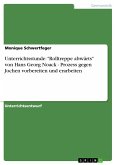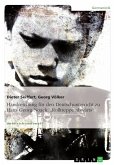Forschungsarbeit aus dem Jahr 2022 im Fachbereich Didaktik - Deutsch - Literatur, Werke, Note: A, University of Illinois at Urbana-Champaign, Sprache: Deutsch, Abstract: The post- World War I presence of black French soldiers and their romantic relationships with German women put the spotlight on the black community in Germany. Many relationships and marriages resulted from those soldiers' presence in the Rhineland. From these relationships were born brown ¿Mischlinge¿, ¿mixed blood¿ or ¿half breed¿ children which the Nazis would call ¿Rhineland bastards.¿ Their presence stirred up hate in German nationalists who began an anti-black campaign in newspapers, books, pamphlets, and caricatures. Nazis perceived the existence of the ¿Rhineland Bastards¿ as a humiliation and a reminder of Germany¿s defeat in World War I. Much has been written on the Holocaust, but the subject of ¿Rhineland bastards¿ as Hitler¿s black victims of the Holocaust has not received much scholarly attention. They were marginalized and no one paid attention to their stories as victims of the Holocaust until the first study on the ¿Rhineland Bastards¿ was published in 1979 by Reiner Pommern. In the wake of this initial scholarly interest in them, some of the ¿Rhineland bastards¿ started sharing their lived experiences through interviews, books, and autobiographies such as Hans Massaquoi¿s Destined to Witness (1999). This paper investigates Massaquoi¿s attempt to fit into German society. It also traces the process by which the Nazi construction of ¿Rhineland bastards¿ was extended to the entire black community in the Third Reich, eventually consolidating racism against blacks in Germany in the aftermath of the Nazi regime.
Hinweis: Dieser Artikel kann nur an eine deutsche Lieferadresse ausgeliefert werden.
Hinweis: Dieser Artikel kann nur an eine deutsche Lieferadresse ausgeliefert werden.







